Fort
William Henry Harrison
46°37'14.83"N
112° 6'1.44"W
1894
- Today
Postcard
featuring Fort Harrison, published by Helena's A. P Curtin
Co., circa 1900

COURTESY
OF THE DAVID POOR COLLECTION
Located
about four miles northwest of Helena, Fort William Henry
Harrison was authorized by an act of Congress in 1892.
The Fort was originally named Fort Benjamin Harrison
in compliment to the then President. The name was changed
in 1906 to eliminate duplication with a fort in Indiana.
The military reservation was acquired by donations through
the efforts of Col. C.A. Broadwater (who owned the nearby
Broadwater Hotel and Natatorium), the local Optimist
Club, and interested private parties.
The
Fort was built from 1894 to 1896. In 1895, a detachment
of the Hospital Corps from Fort Assinboine south of
Havre and several small military posts, which were
scheduled to close in the Dakotas, began training
at the post. The Montana National Guard began utilizing
Fort Harrison for training in 1911, after abandoning
Fort Ellis near Bozeman.
|
Helena
Independent - Fort Harrison Under Construction, Nov.
11, 1894
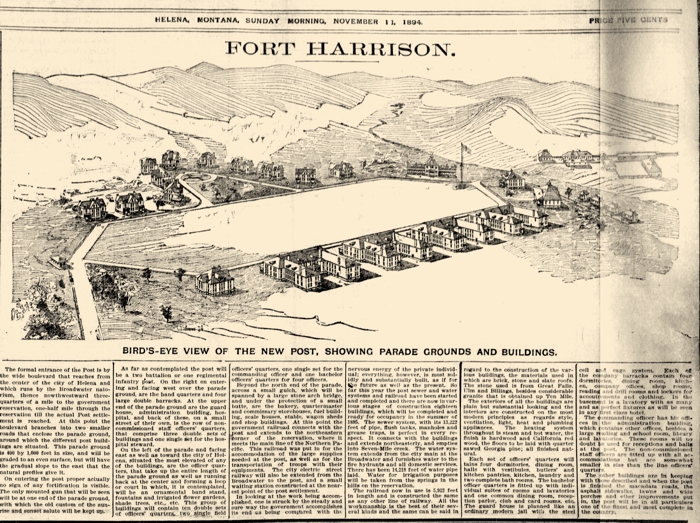
CLICK
ON IMAGE FOR A BIG VERSION IN A NEW WINDOW
Fort
Harrison, About 1910
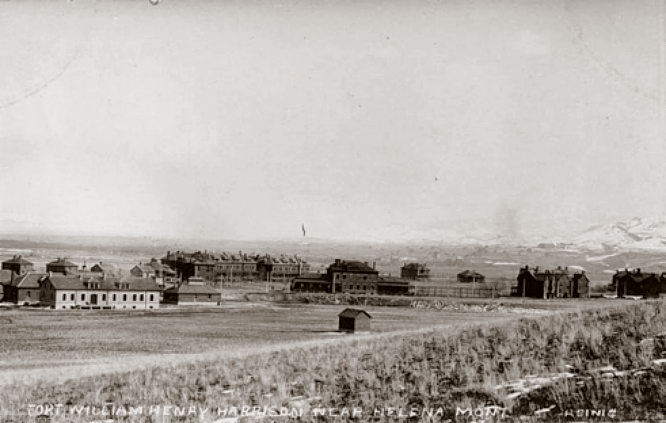
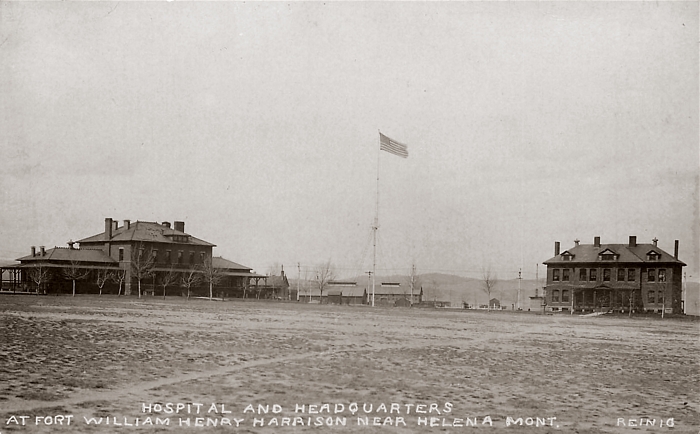
COURTESY OF THE DAVID POOR COLLECTION • CLICK
ON IMAGE FOR A BIG VERSION IN A NEW WINDOW
Soldiers'
Quarters

COURTESY
OF THE DAVID POOR COLLECTION • CLICK
ON IMAGE FOR A BIG VERSION IN A NEW WINDOW
Soldiers'
Quarters, Looking Southeast

COURTESY
OF JOHN JOHNSON
Soldiers'
Quarters, Looking Northwest
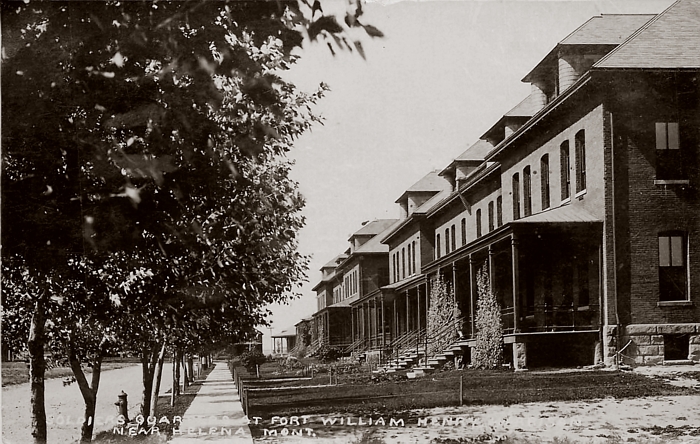
COURTESY
OF THE DAVID POOR COLLECTION • CLICK
ON IMAGE FOR A BIG VERSION IN A NEW WINDOW
Fort
Harrison Band Quarters, Bowling Alley and Post Exchange
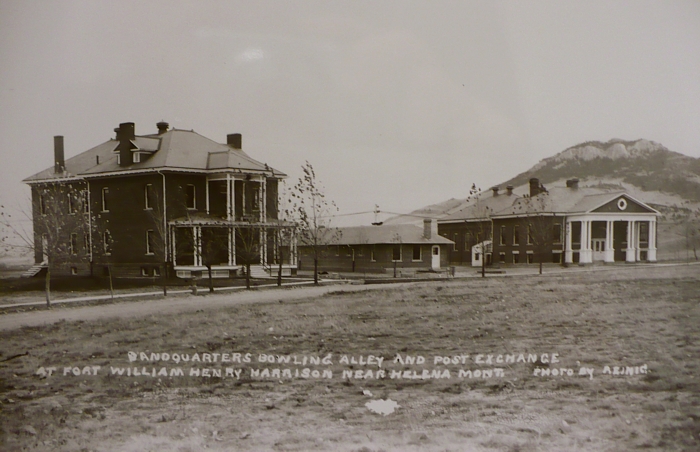
COURTESY
OF JOHN JOHNSON • CLICK ON IMAGE
FOR A BIG VERSION IN A NEW WINDOW
Post
Exchange
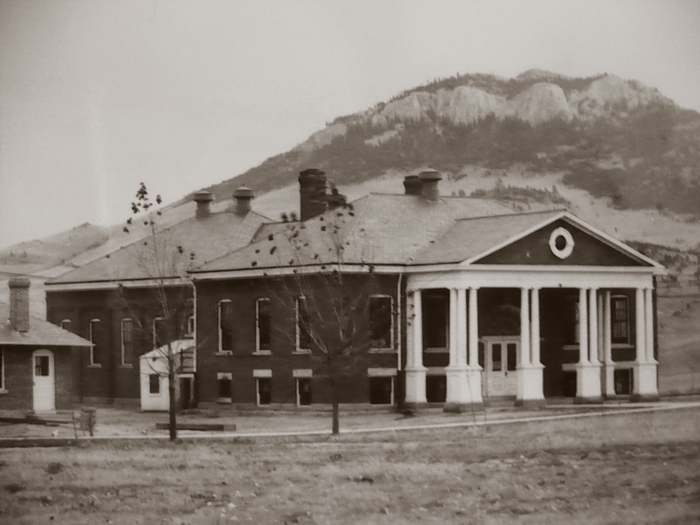
COURTESY
OF JOHN JOHNSON
Rare
Token from the Fort Harrison Post Exchange
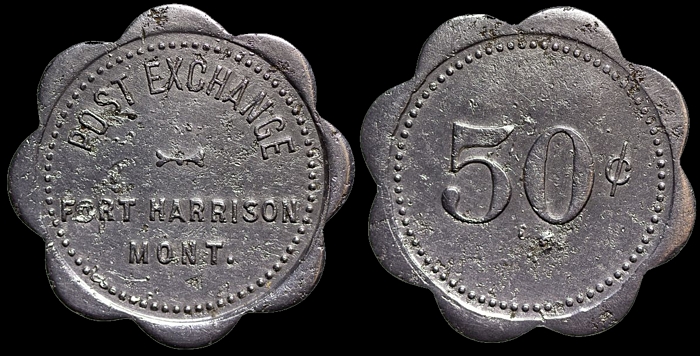
"NCO
Row" Housing, Early 1900s
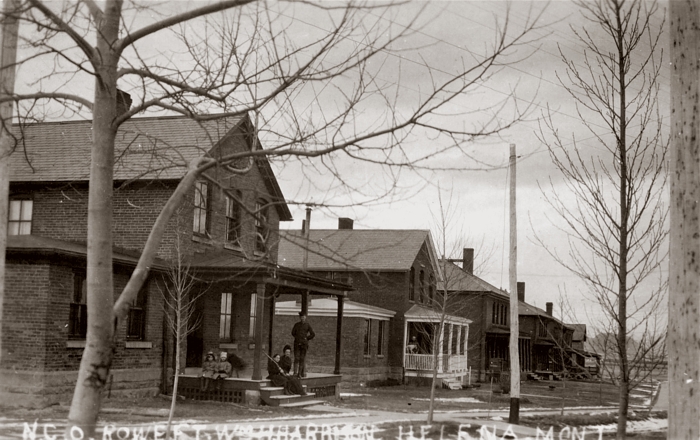
COURTESY
OF THE DAVID POOR COLLECTION • CLICK
ON IMAGE FOR A BIG VERSION IN A NEW WINDOW
These
buildings still stand on Middle Road, just northwest of
the V. A. Hospital complex...

Fort Harrison Band
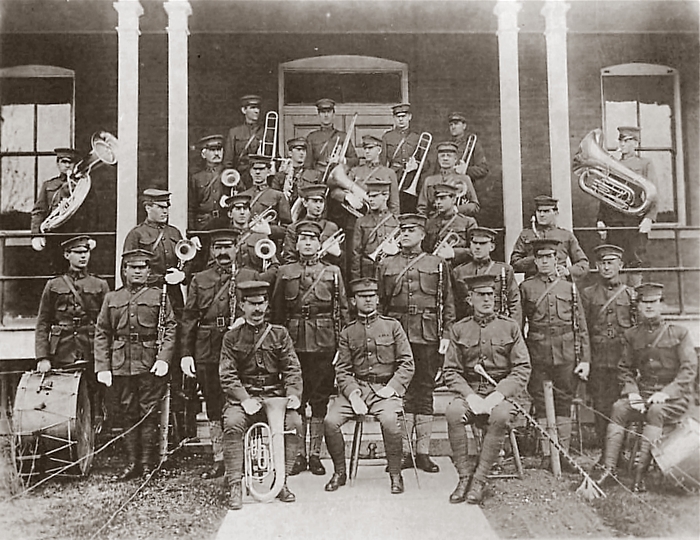
COURTESY
OF THE DAVID POOR COLLECTION
Fort Harrison 14th Infantry Orchestra

COURTESY
OF THE DAVID POOR COLLECTION • CLICK
ON IMAGE FOR A BIG VERSION IN A NEW WINDOW

Sixth
Infantry March, 1909
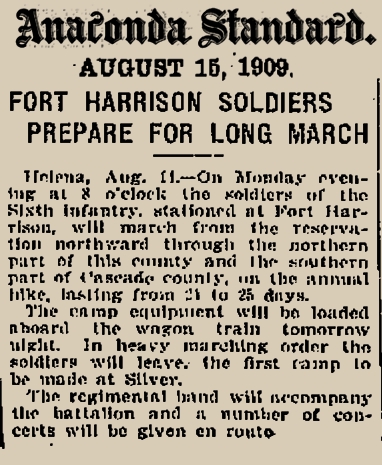
| It
is not known if the following three photographs of Fort
Harrison troops show the August 1909 march, but they
appear to be of that period, and the country shown could
easily be on the route described in the Anaconda Standard
piece... |
Troops
and Wagons on a Hillside Road

COURTESY
OF THE DAVID POOR COLLECTION • CLICK
ON IMAGE FOR A BIG VERSION IN A NEW WINDOW
Possibly
what is now Chevallier Drive, northwest of Helena
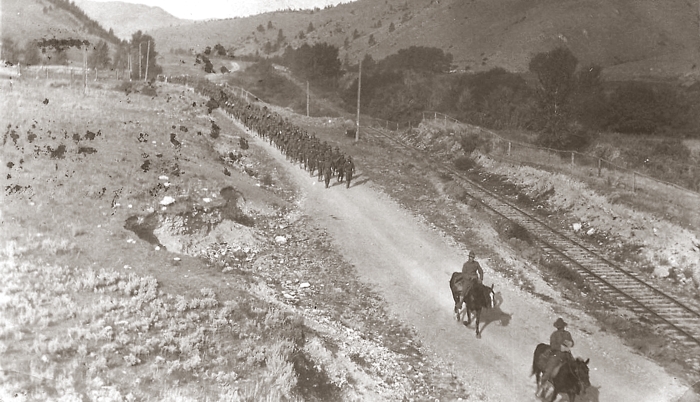
COURTESY
OF THE DAVID POOR COLLECTION • CLICK
ON IMAGE FOR A BIG VERSION IN A NEW WINDOW
Riverside
encampment

COURTESY
OF THE DAVID POOR COLLECTION • CLICK
ON IMAGE FOR A BIG VERSION IN A NEW WINDOW

|
Fort
Harrison was abandoned in 1913 and left in the charge
of a caretaker by the U.S. Army. The Montana National
Guard occupied the Fort in September 1915, beginning
the development of the military post we see today.
In
June 1916, the Montana National Guard was notified
by the War Department to mobilize to guard the U.S.-
Mexican border. With the start of World War I, the
Guard was again trained and mobilized in 1917 to protect
major railroad and industrial facilities, until they
could be dispatched to eastern camps and eventually
overseas.
|
Montana
National Guard Troops, about 1917
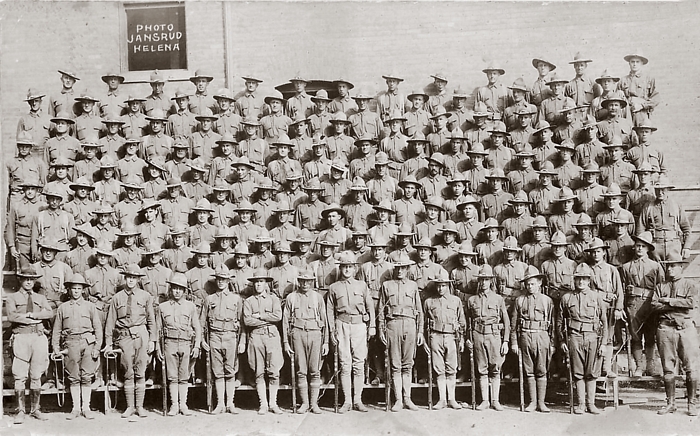
COURTESY OF THE DAVID POOR COLLECTION • CLICK
ON IMAGE FOR A BIG VERSION IN A NEW WINDOW
Troops
on Parade at Fort Harrison, circa 1917
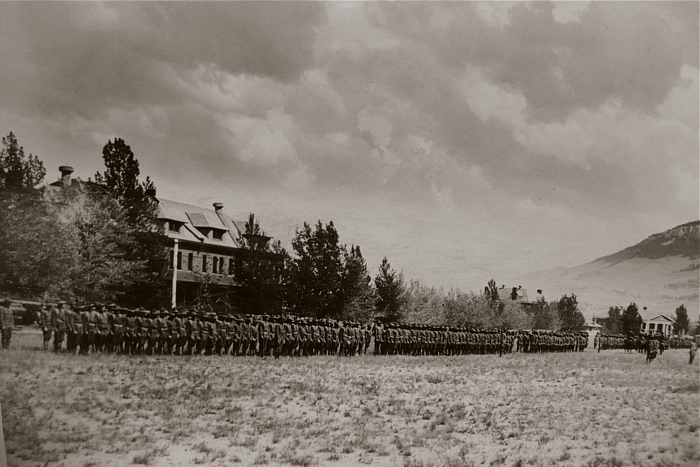
COURTESY
OF JOHN JOHNSON • CLICK ON IMAGE
FOR A BIG VIEW IN A NEW WINDOW
163rd Montana Infantry Regiment, Oct. 24, 1917
Leaving for the European War Theater
Taken from what is now known as the Iron
Front Building
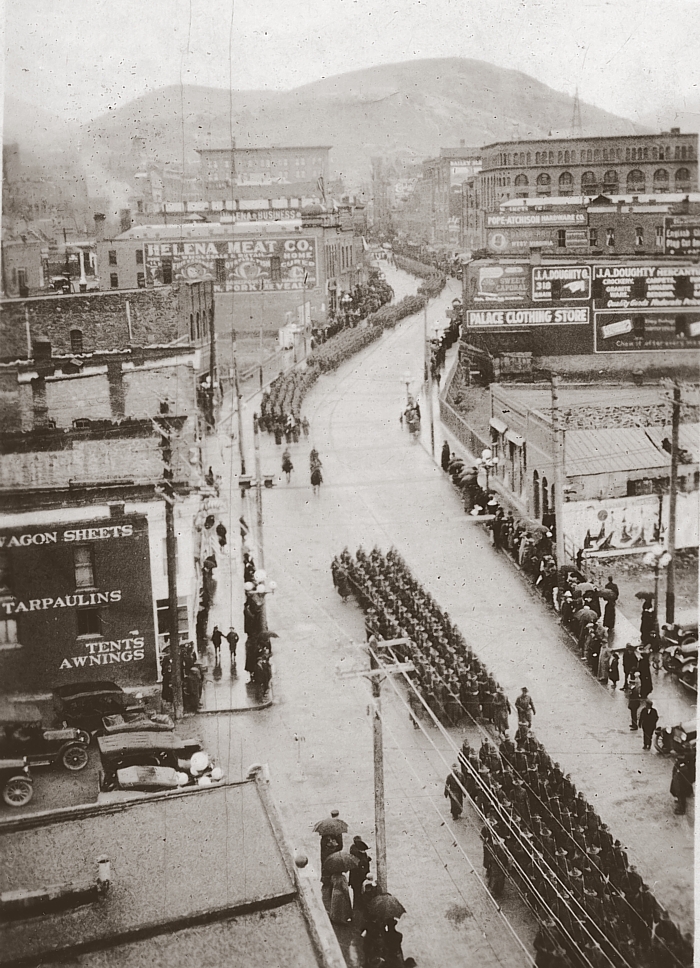
COURTESY
OF TERRY WAREHAM • CLICK ON IMAGE
FOR A BIG VIEW IN A NEW WINDOW
|
After
World War I, the fort became a Public Health Service
hospital and eventually a Veterans Administration
medical facility (No. 72). During its first years
in that capacity, it was designated as a tuberculosis
hospital and expanded to 300 beds. In 1925, the
designation was changed to a general medical and
surgical hospital.
For
a time, there was trolley service between Helena
and the fort, with a connecting line running north
on Spring Street, in the Seymer Park Addition, between
the Broadwater Hotel and the fort.
|
Montana
National Guard Encampment, June 1927
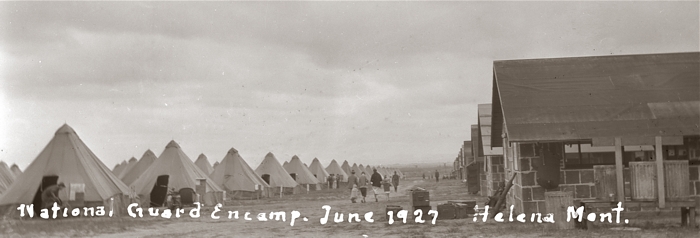
COURTESY
OF SEAN LOGAN • CLICK ON IMAGE
FOR A LARGE VERSION IN A NEW WINDOW
Fort
Harrison Hospital, ca. 1928

COURTESY
OF TOM KILMER • CLICK ON IMAGE
FOR A LARGE VERSION IN A NEW WINDOW
New
Hospital, 1932
Bricks Were Made Just One Mile Away •
Granite Quarried at Clancy
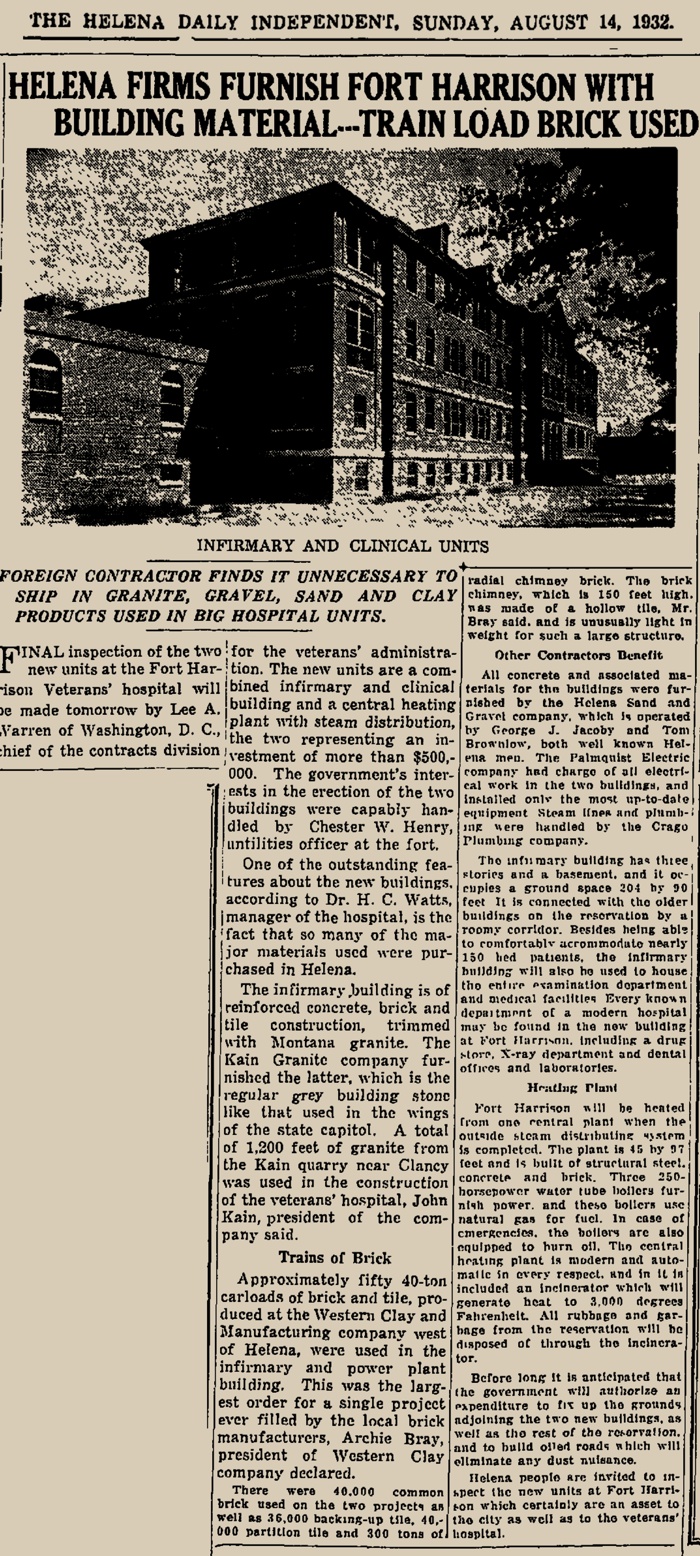
1932
Hospital - East Side
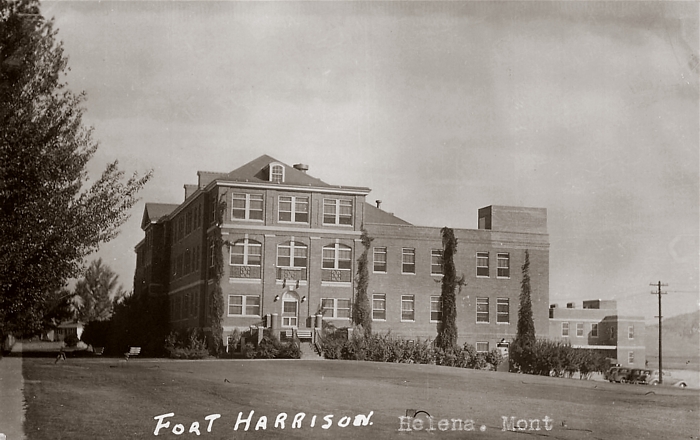
COURTESY
OF THE DAVID POOR COLLECTION • CLICK
ON IMAGE FOR A BIG VERSION IN A NEW WINDOW
The
hospital was damaged by the 1935 earthquakes. It reopened
in 1937.
163rd Infantry, Montana National Guard
on Parade in Helena, June 21, 1933
L. H. Jorud Photo from the Baird Collection
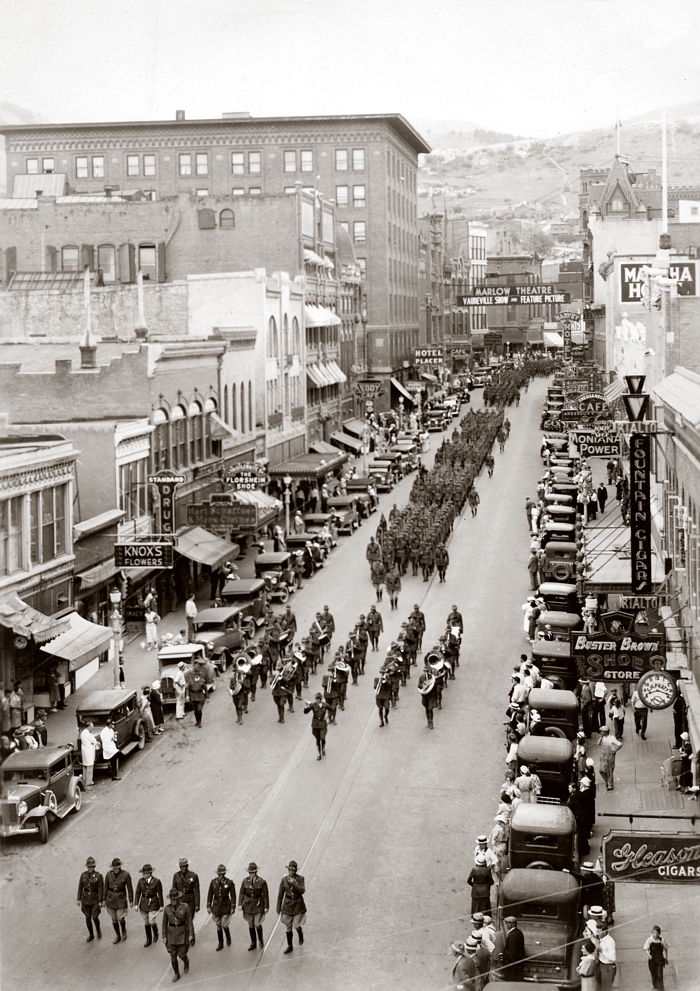
CLICK ON IMAGE
FOR A LARGE VERSION IN A NEW WINDOW

1st
Special Service Force Training, 1942-43
| During
the Second World War, the U.S. Army assumed control
of Forth Harrison, and used it for very new and distinctive
military units. These units included the 1st
Special Service Force, the 474th Quartermaster Truck
Regiment, and the War Dog Training Center (Camp Rimini).

First
Special Service Force Shoulder Patch
The
Devil's Brigade (also called The Black Devils and
The Black Devils' Brigade), officially the 1st Special
Service Force, was a joint World War II American-Canadian
commando unit organized in 1942 and trained at, and
in the vicinity of, Fort William Henry Harrison near
Helena, Montana in the United States. The brigade
fought in the Aleutian Islands, Italy, and southern
France before being disbanded in December 1944. The
modern American and Canadian Special Forces units
trace their heritage to this unit.
|
Fort Harrison Encampment, ca. 1943
View taken from a training tower

KENNON BAIRD COLECTION • CLICK
ON IMAGE TO OPEN A BIG VERSION IN A NEW WINDOW
1st
Special Forces Ceremony at the Fort, 1943
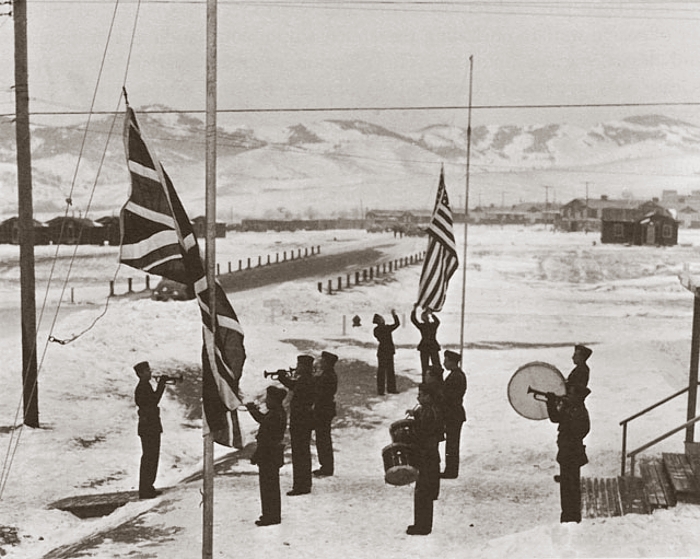
WWII
Encampment Seen From the Hospital
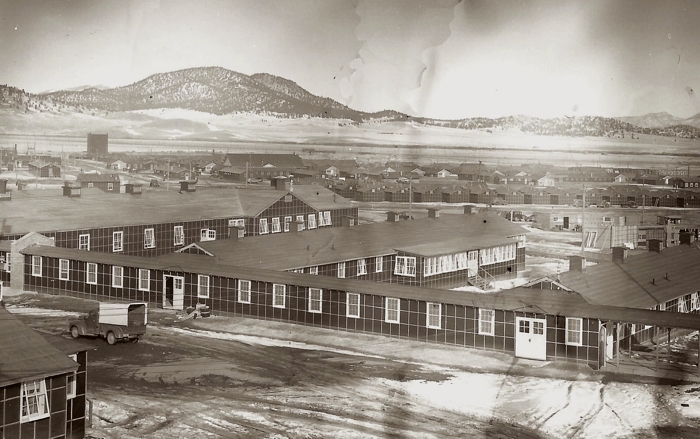
COURTESY
OF THE INDEPENDENT RECORD • CLICK
ON IMAGE TO OPEN A BIG VERSION IN A NEW WINDOW
| On
April 6 1943, the First Special Service Force paraded
down Main St., on their way to the European front... |
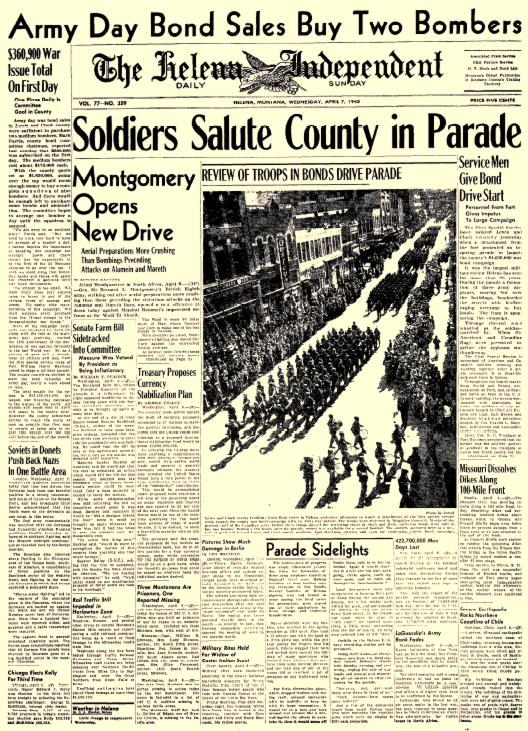
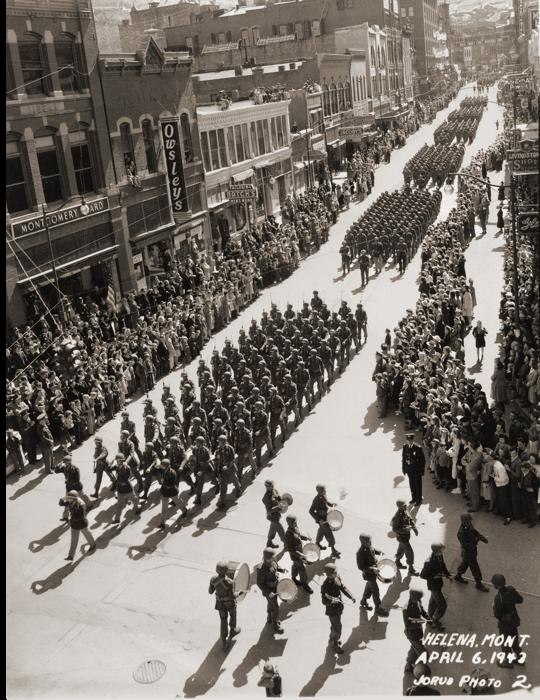
COLLECTION
OF KENNON BAIRD • CLICK ON IMAGE
TO OPEN A BIG VERSION IN A NEW WINDOW
Documentary Film "Devil's Brigade - To Helena and Back"
| Documentary
about the US-Canadian First Special Service Force in
WW2. Specifically about many of the men that returned
to live in Helena, Montana after the disbandment of
the Force and the end of the war. Written, produced
and directed by Ray Ekness. |
1968
Feature Film, "The Devil's Brigade"
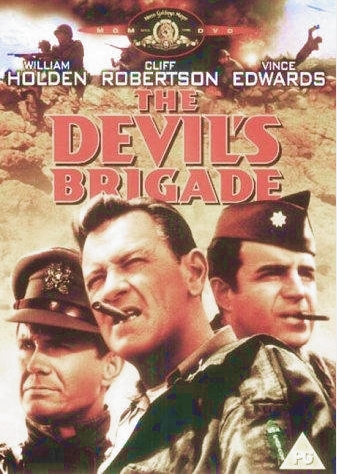
| Based
on the wartime explots of the First Special Service
Force, "The Devil's Brigade" was filmed in
Utah and Italy, with the National Guard camp north of
Lehi, Utah as Fort Harrison. For more about this film,
click
here. |
Fort
Harrison Hospital Buildings and Campus, 1940s
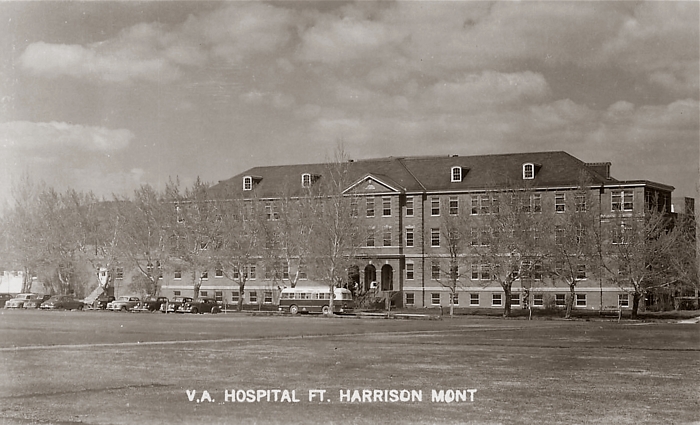
COURTESY
OF THE DAVID POOR COLLECTION • CLICK
ON IMAGE FOR A BIG VERSION IN A NEW WINDOW
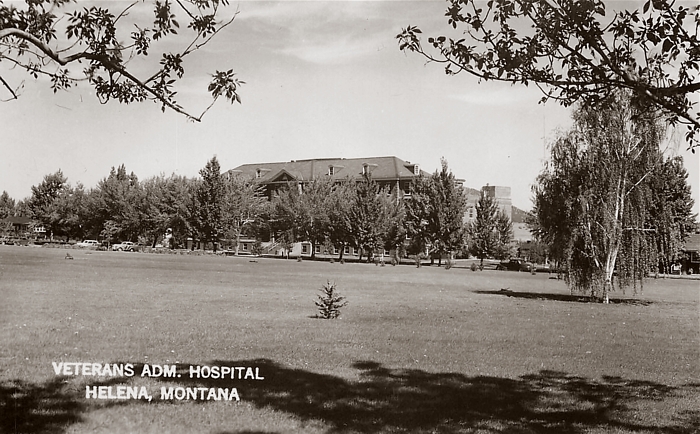
COURTESY
OF THE DAVID POOR COLLECTION • CLICK
ON IMAGE FOR A BIG VERSION IN A NEW WINDOW
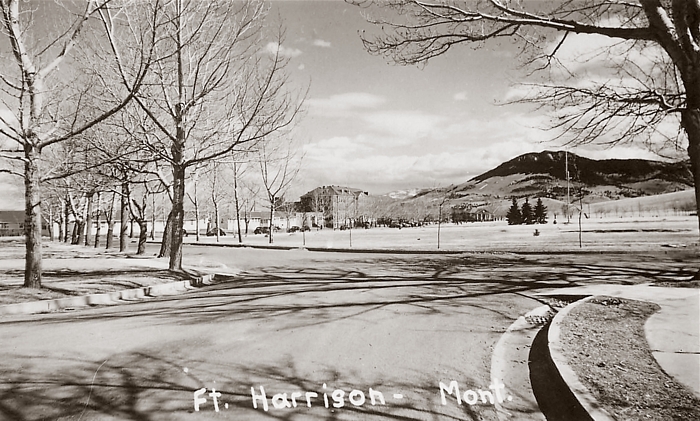
COURTESY
OF THE DAVID POOR COLLECTION • CLICK
ON IMAGE FOR A BIG VERSION IN A NEW WINDOW

COURTESY
OF THE DAVID POOR COLLECTION • CLICK
ON IMAGE FOR A BIG VERSION IN A NEW WINDOW
Parachutists, 1940s
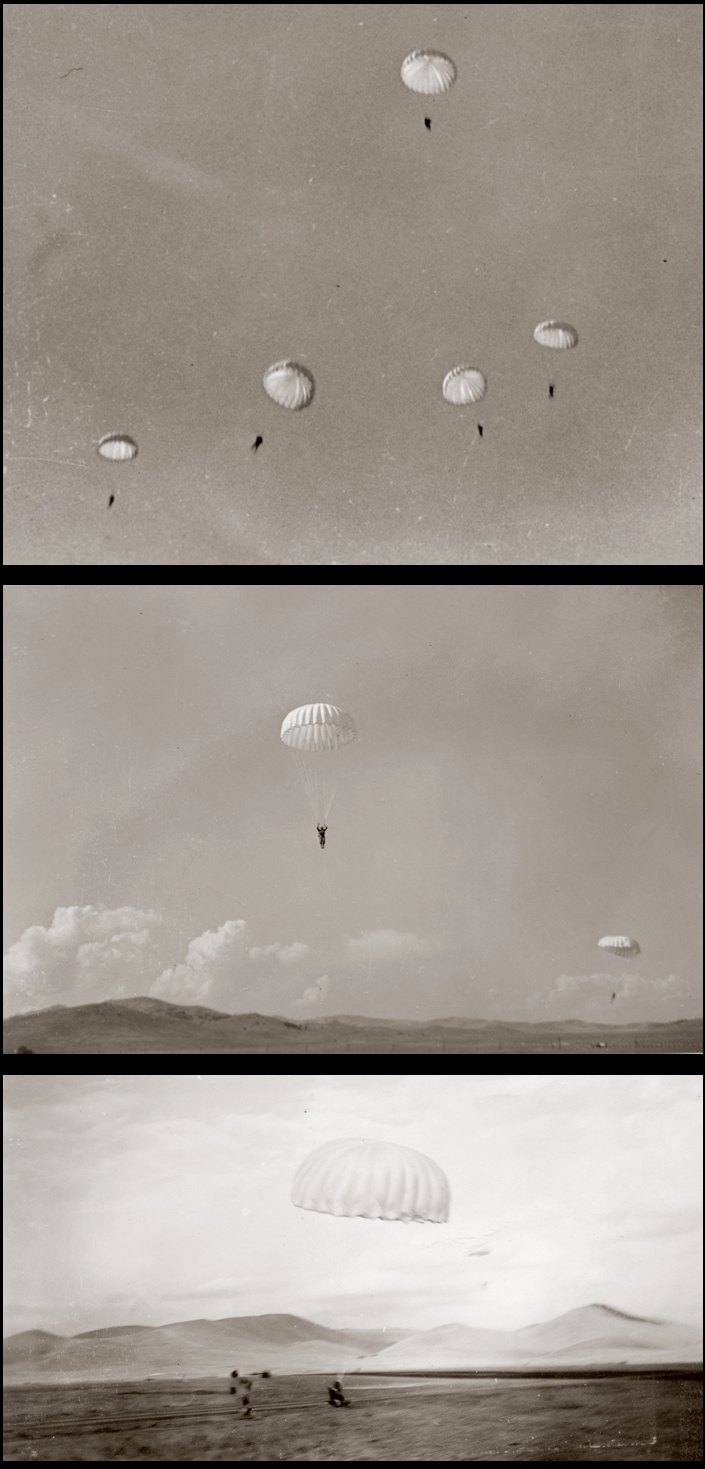
COURTESY OF THE KENNON BAIRD COLLECTION
Souvenir
Ashtray, 1940s

COURTESY OF THE DAVID POOR COLLECTION
Souvenir Printed Silk Pillow Sham, 1940s
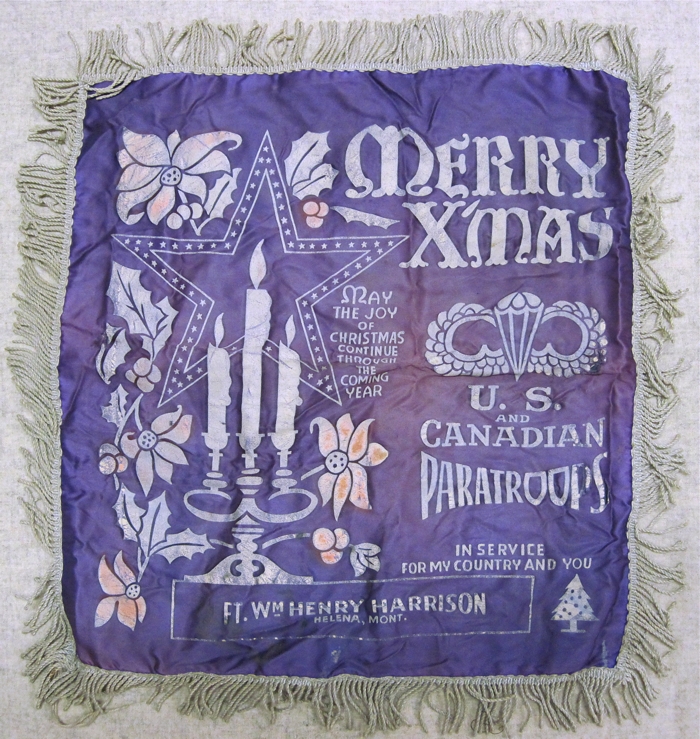
COURTESY
OF THE DAVID POOR COLLECTION •
Actor
Robert
Young Visits Fort Harrison, 1943
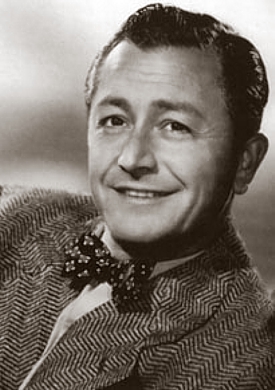

Aerial
View of Fort Harrison, July 1947, Showing Wartime Configuration

CLICK
ON IMAGE TO OPEN A BIG VERSION IN A NEW WINDOW
Machine
Gun on Fixed Display at the Fort, 1940s

COURTESY
OF TOM KILMER
| This
gun was on the south side of the circular drive which
runs through the campus. Your editor remembers it from
the mid-1950s |
Early
1950s Hospital Complex Configuration
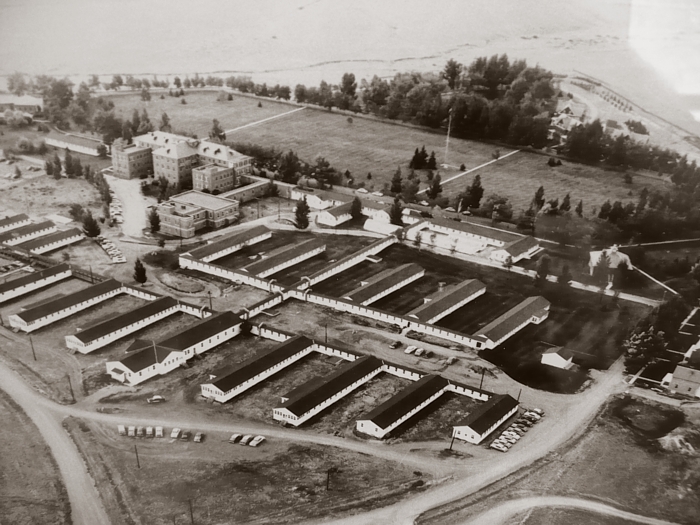
COURTESY
OF JOHN JOHNSON • CLICK
ON IMAGE FOR A BIG VERSION IN A NEW WINDOW
| The
maze of white red-roofed frame buildings was dismantled
beginning in 1961 to make way for construction of the
present hospital. Some of the buildings were moved and
put to other uses. |

Veterans
Bedside Radio Network Studio, 1950
PHOTOS
FROM THE COLLECTION OF KENNON BAIRD
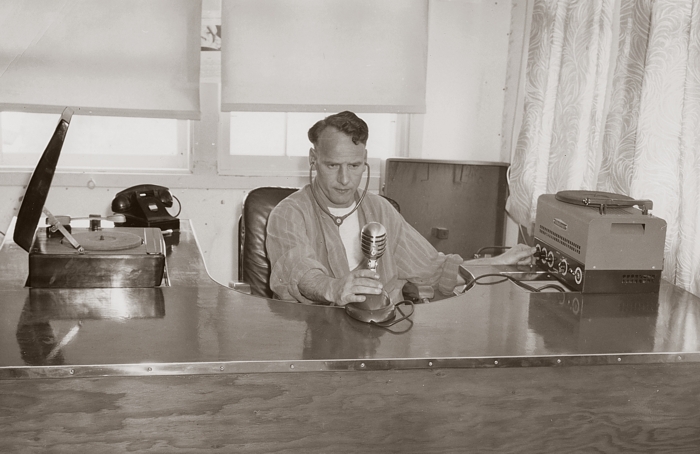
CLICK ON IMAGE FOR A BIG VIEW IN A
NEW WINDOW
Fort
Harrison had one of 165 Bedside Radio Network "radio
stations", which piped information and entertainment
to the nation's Veterans Administration hospital wards.
Along with the original programs produced in the hospitals,
commercial broadcasts from outside were also provided.
For more about how the system operated, please see the
March 1954 Popular Mechanics Magazine article
linked to below.
These photos of the Fort Harrison studio were taken
in 1950; the nationwide service began in 1946. |
Veterans
of Foreign Wars Dignitaries in the Studio, 1950

CLICK
ON IMAGE FOR A BIG VIEW IN A NEW WINDOW
|
The
man wearing the bow tie is VFW commander in chief
Clyde A. Lewis, from Plattsburg, NY. The metal plaque
on the front of the desk reads:
Donated
by
Ladies V. F. W. Auxiliaries
Department of Montana
Record Cabinet, Announcers Desk 1948-1949
Filing case, Tape Recorder, Record Cabinet 1950

|
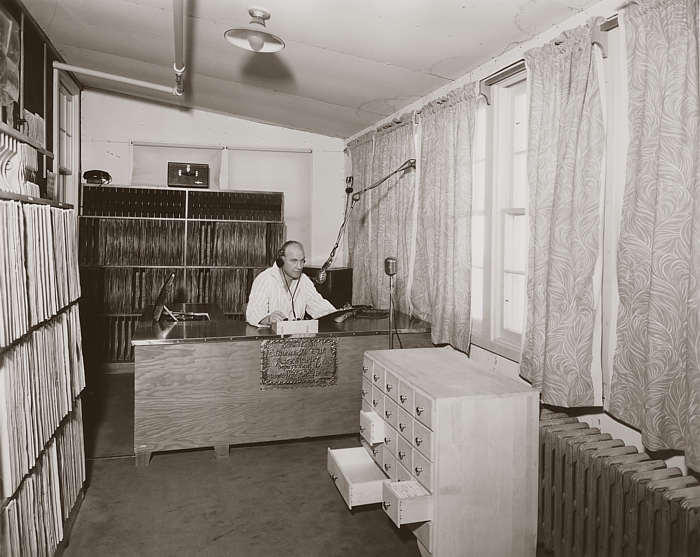
CLICK
ON IMAGE FOR A BIG VIEW IN A NEW WINDOW
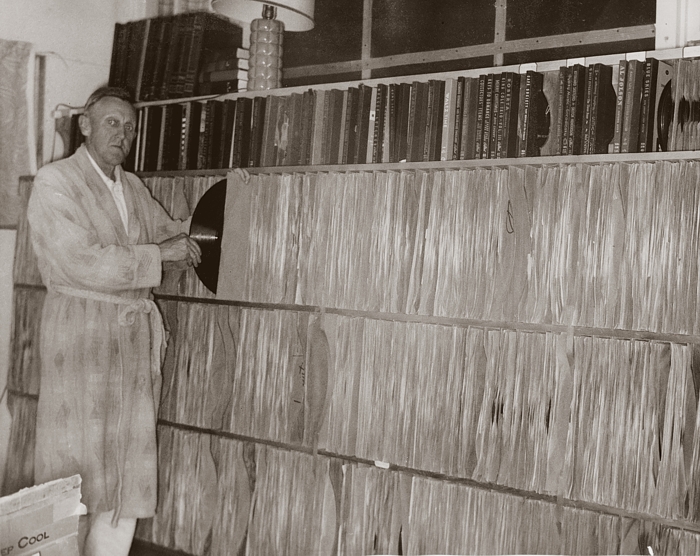
CLICK
ON IMAGE FOR A BIG VIEW IN A NEW WINDOW
Singer
Nelson Eddy Visits Fort Harrison
Broadcasts Over Bedside Network, 1950
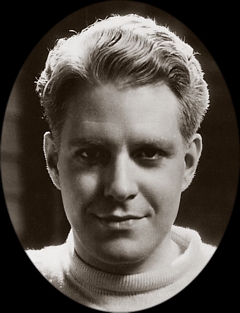
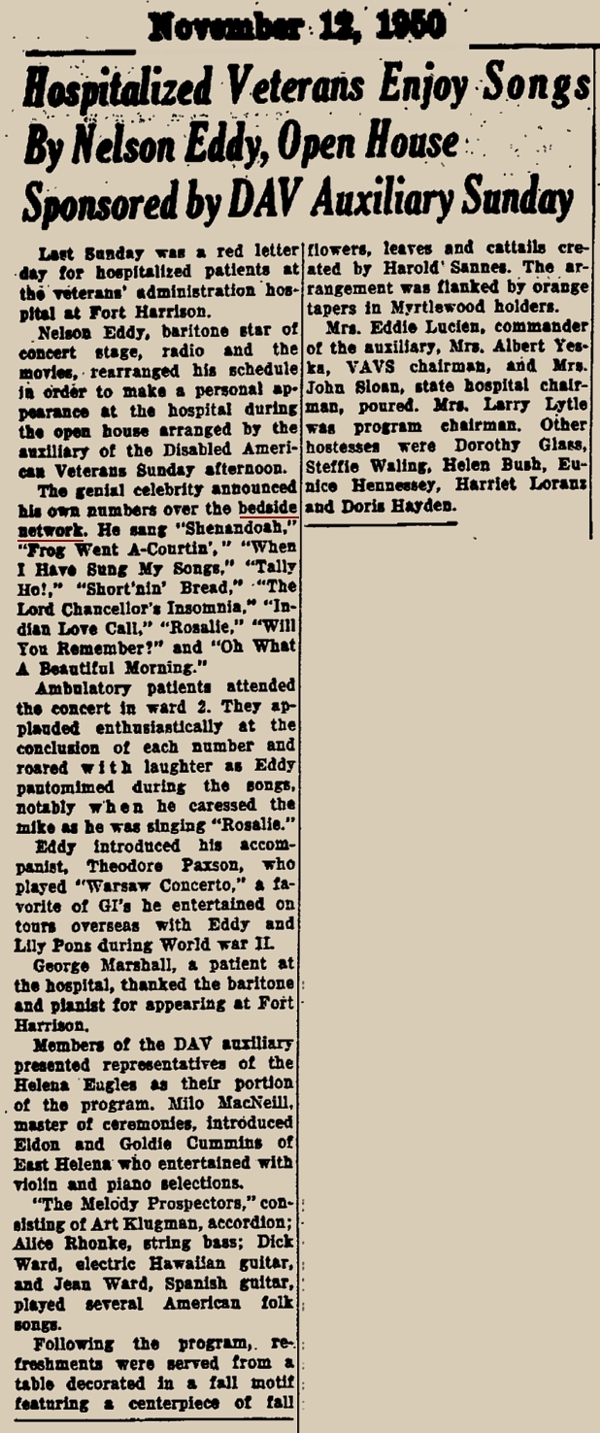
The
Bedside Radio Network Story
Popular Mechanics Magazine, March 1954

CLICK
ON IMAGE TO OPEN THE FULL ARTICLE IN A NEW WINDOW

New
Hospital and Other Upgrades


COURTESY
OF THE DAVID POOR COLLECTION
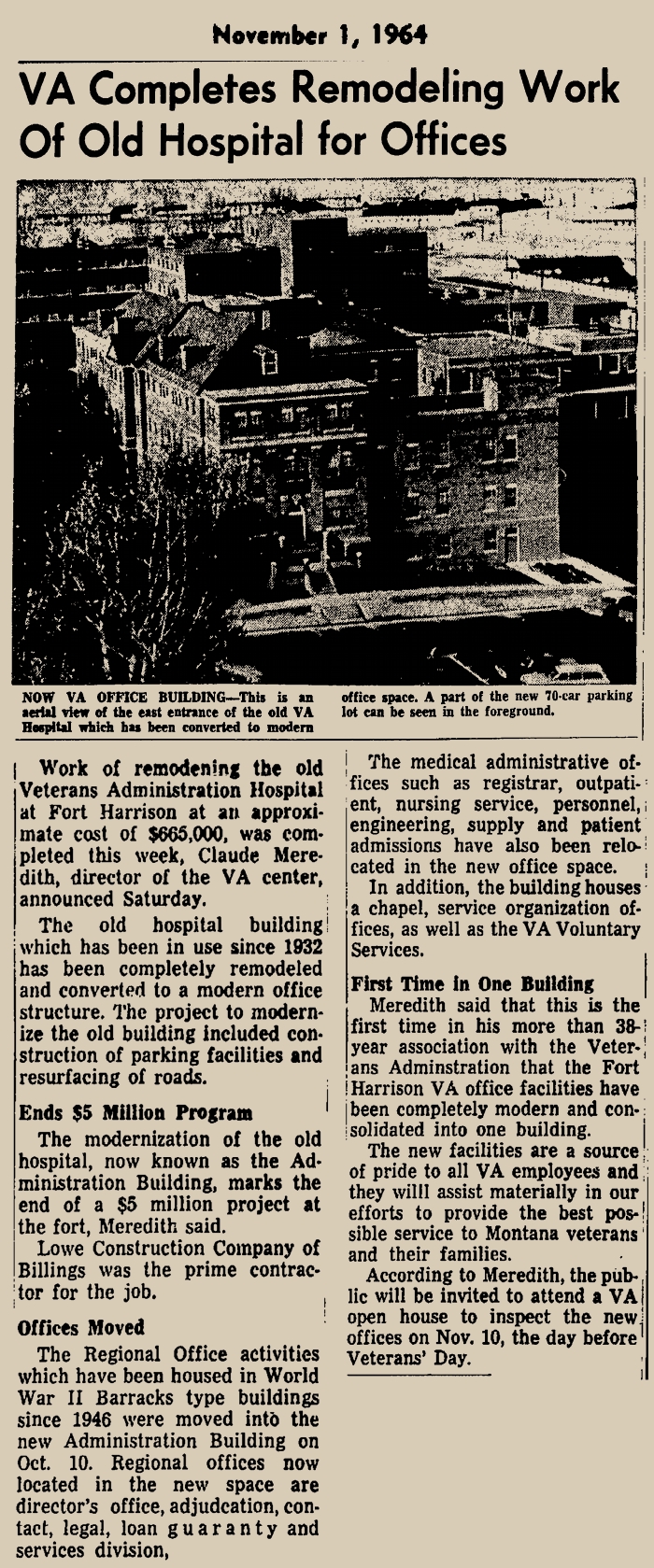
1974 Camp Thomas L. Judge Sign
Courtesy of Jack Womack
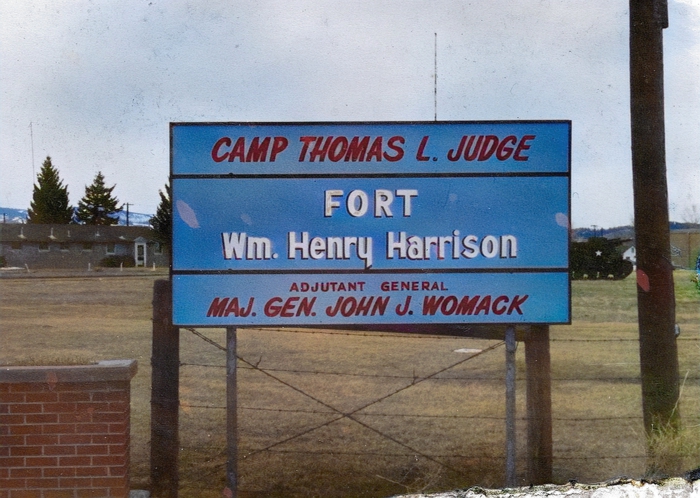
|
Since
1947, the Fort has been used for training by numerous
active and inactive combats, support and combat service
support units. Numerous major improvements and increased
training facilities were completed at Fort Harrison
in 2001.
Fort
Harrison is the site of the Montana
State Veterans Cemetery, and the home of the Montana
Military Museum.
|




























































